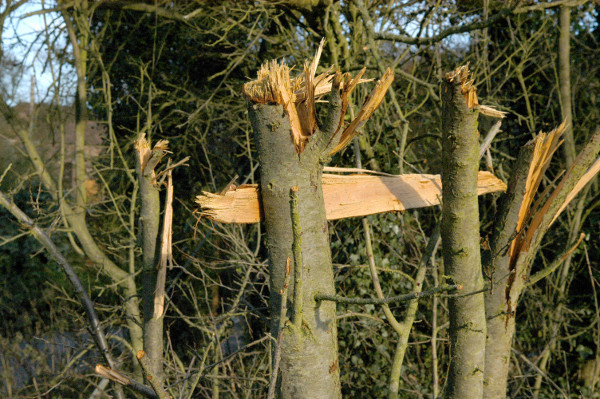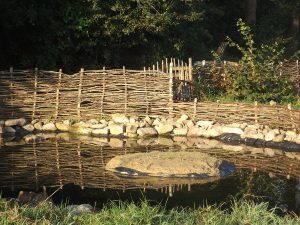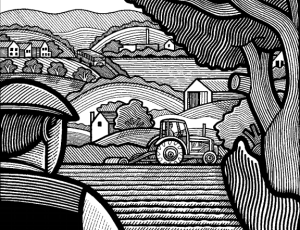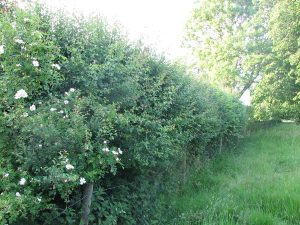One of the most damaging post-war developments in hedgerow preservation was the increase in mechanised cutting of hedges, in particular using the flail. Above is a picture of a blackthorn hedge that has recently been flailed (picture by Donato Cinicolo). The damage is obvious.
Traditionally hedges were either trimmed or laid by hand. This was laborious work, but it was done with care and attention to the individual plants. Flail cutting means that hedge trees are repeatedly cut at the same point, this causes them to become gnarled and unhealthy, and can lead to a decline in the quality of the hedge (with resultant loss of biodiversity in the local environment). It also leads to a loss of mature hedgerow trees (as the older hedgerow trees die out and insufficient younger specimens are allowed to grow to maturity).
One can understand the problems farmers face in a more intensive farming environment – hedgelaying is the most effective way to maintain a hedge but is considerably more expensive than machine cutting.
There have been some improvements in the guidelines farmers follow when cutting hedges. The Tree Council suggest tagging trees to be allowed to grow to maturity, there are guidelines on how often a hedge should be cut and so on. However the most effective way of protecting our hedges would be to change the way that subsidies for hedgelaying are administered.
Currently there are two government schemes encouraging good environmental practice to which farmers can belong. The schemes are called Entry Level Stewardship (ELS) and Higher Level Stewardship (HLS). Subsidies for hedgelaying are only available to HLS members, a scheme that is restricted to certain landscapes and areas, such as heathland, moorland, coastal land, wetland, and small woodlands, especially where these exist on or adjacent to Sites of Special Scientific Interest.
It would cost money to extend hedgelaying subsidies to members of the more common scheme, the ELS, but it would be a simple and effective way to direct help to hedgerows in all areas, and to foster the art of hedgelaying*.
These are difficult economic times, but if as a nation we are going to place obligations on farmers as stewards of the land, it is only reasonable that we sometimes share the costs involved. Hedgelaying is not a cheap or easy process, but it makes a huge difference to our environment.
*This idea was suggested to me by Robin Dale of the National Hedgelaying Society.





12 Comments
It never occured to me that Hedge laying could create an impenetrable barrier to keep animals in field and deer out. Considering the cost of fencing and the hazards of having animals escaping onto roads that could make hedge laying an attractive option.
This method of landscape management is an utter diabolical disgrace. It shouts that we do not care a hoot for nature, this hurts my soul so profoundly seeing our hedgerows butchered like this every year and it startles me that we have allowed such a monopoly of farming to change our country so definitively. Just who exactly allowed this handful of men to own thousands and thousands of acres, buying up all the small farms, who allowed these few men to take over Farming in the UK? These businessmen have fired so many land workers, destroyed communities, sold the homes or have allowed them to go to ruin, they have bought in immense gas guzzling machines that do the work of twenty men, which has only served to utterly ruin the farming community in one foul Century. And then they have the gall to tell us that we are losing the Bees, that Ash Trees, Beech Trees and Oak Trees are all dying, explaining how our country side is suffering on so many levels, whilst trying to convince us G.M.O is the way forwards. When are the good men and women of the UK going to realise how successfully they have been played and duped by a small group of despicable, cold, greedy men and find the gumption and wherewithal to take back our Country?????
Don’t know if you’ve seen this – http://lowimpactorg.wpengine.com/live-from-the-real-farming-conference-equality-in-the-countryside-a-rural-manifesto/
A new rural manifesto by the Landworkers’ Alliance and the Land magazine.
I live in The Vale of Glamorgan South Wales & see much evidence of hedgerows being cut using a flail. In contrast, having holidayed frequently in The Cotswolds, the management of hedgerows there is so much more sympathetic with widespread – evidence of hedgelayjng and planting of new hedge is widespread
Flail cutting is widespread here in North Yorkshire – I’ve contacted the local wildlife trust in the past, when I’ve seen it done during nesting season, but they don’t seem to be able to do much, just said ‘some farmers have special permission to cut then’ – ie. some farmers can do what they want, and hang the consequences. It makes me angry and sad that they can do this when birds are nesting – especially when it’s illegal to disturb nesting birds. Then they do it again in the autumn, destroying all the fruit and berries – which are beneficial for us and wildlife. It’s more evidence of the triumph of greed and money over what is best for the environment.
Here in Lincolnshire the hedge flailing seems to start earlier than ever; the farmers now start as soon as they have the crop taken in which is now much earlier than in the past. This results in the annihilation of the autumn fruit harvest which would feed the birds and small mammals (and also our blackberry and sloe harvest!) There’s little point in creating wildlife edges to the fields for nesting birds, only to destroy their autumn food supply needed to prepare themselves for winter. Also the flailing covers all our country roads in jagged twigs and thorns which are a nightmare for bike riders – it’s simply impossible to get through a journey without a puncture. Again – rather pointless to promote bike riding and the sustrans cycle path routes and then have them made impassable.
I know this will sound naïve couldn’t the good people in each area, who already have hedge laying skills teach other interested party’s to do it too, I personally would love to learn how to do this and I’m not daft enough to know it won’t take time, it would have to be done on a voluntary basis as the cost of having done seems to be one of the stumbling blocks at present, flailing is cruel, I love trees well all of nature really and I would like to help properly not just by signing petitions action is needed and there are people ready and waiting to do this I’m sure, I am going to see if I can find a hedge laying course here in Staffordshire. I hadn’t realised why the hedges looked so damaged thankfully I now know, one of our country parks near where I lived must use a flailing machine it breaks my heart, leaving trees and hedges in these states allows disease to get in and kill them off, this is a criminal waste of a wonderful resource for nesting birds, insects and much much more,
This post may be a few years old, but the problem is getting worse, not better. Loss of biodiversity is reaching critical point with cascade failure a real possibility. Hedgehogs and Yellowhammers, once common enough across our countryside, are now on the Red List of endangered species, we’ve almost lost the Cirl Bunting altogether and others are sure to follow if nothing is done.
Farmers have it in their hands to back off the blades and leave some foliage on the bush when they cut, meaning second-year growth has a chance to bear fruit. Cutting again in early spring as many do compromises the hedge even further, and all we are seeing now across the landscape is row upon row of barren, stricken sticks. The countryside is silent.
Hedgerow Defenders was set up in 2020 with a website and a Facebook page. In contact with people who could potentially make a difference, HD seeks to turn the tide on hedgerow management before it’s too late. Having lost all songbird species bar Blackbird and Robin (garden nesters) in our immediate area, it’s clear that the problem is in desperate need of redress and that thugging (hugging the hedge closely with tractor blades) is not a sustainable form of environmental management. Please do all you can to spread information on this issue and join groups seeking to protect the countryside for future generations.
Hi Hedge Defenders – I’m just wondering if you fancy doing a bit of an updated blog about it all now? Get in touch if so – [email protected]
Thanks!
Thank you Rebecca, I have emailed you. Clearly traction is slowly being gained but everyone reading this needs to do something in defence of sustainable land management – the countryside needs you right now, and may suffer irreparable damage without your help. Please support Low Impact and any other organisation that is in a position to press for change – e.g. local Wildlife Trusts, the RSPB, BTO, Nature Friendly Farming Network and the Farming and Wildlife Advisory Group…. DEFRA, Natural England and Hedgelink are also worthy contacts. You can find more information on the hedgerow crisis and useful links on Hedgerow Defenders‘ website.Thank you for adding your voice in defence of Britain’s fragile ecology. There is absolutely no time left to waste.
Perhaps all those on here crying about the state of the hedges that the farmers have cut via flail etc
Take out your pruning shears and put your money where your mouth is and cut them for us.
You all cry you can’t see around corners of minor roads when the hedges are growing wild.
You all cry when they are cut !
So if you’re all that worried about the hedge rows get off your ass’s , leave the keyboard and use a pair of hedge shears,
By the time you get your first 100yards done then stop and think what crap a farmer listens to you all bloody moaning!!
Concerned farmer
It’s not the farmers’ fault, They’re forced to compete to provide the cheapest food possible for supermarkets. So really, it’s not valid to criticise farmers without criticising the entire system. Governments are too busy subsidising the fossil fuels and weapons industries to subsidise farmers to do the right thing re hedges (and not flailing is the right thing). Land is often owned by absentee landlords (such a feudal word), who don’t care about the ecology of the land, just the income from it. Farmers are being squeezed for corporate profits just like everybody else. There used to be many more farm workers per acre, so that hedges could be laid prpoerly every 10-15 years, but now, in a race to the bottom for cheap supermarket food, that’s not possible. In a commons system, farmers who lay their hedges could receive a rent reduction, and food production could be geared more to providing employment and environmental benefits, not just cheap, chemically-produced, not-very-nutritious food.
As it says here – https://www.lowimpact.org/posts/why-farm-hedge-trimming-needs-to-change – It would be interesting to look at the cost of no or reduced annual trimming as opposed to laying a hedge say every 10 years to 15 years, depending on altitude. The costs of labour and machinery in both cases would need to be assessed to prove if the reduction in labour and machinery for annual trimming is any more (or less) than laying a hedge over a longer time period.